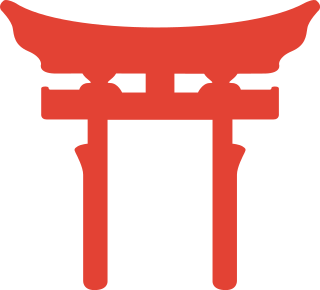Related Research Articles

The Kokin Wakashū, commonly abbreviated as Kokinshū (古今集), is an early anthology of the waka form of Japanese poetry, dating from the Heian period. It is an Imperial anthology, conceived by Emperor Uda and published by order of his son Emperor Daigo, in about 905. Its finished form dates to c. 920, though according to several historical accounts the last poem was added to the collection in 914. The compilers of the anthology were four court poets, led by Ki no Tsurayuki and also including Ki no Tomonori, Ōshikōchi no Mitsune, and Mibu no Tadamine.

The Shoku Nihongi (続日本紀) is an imperially commissioned Japanese history text. Completed in 797, it is the second of the Six National Histories, coming directly after the Nihon Shoki and followed by Nihon Kōki. Fujiwara no Tsugutada and Sugano no Mamichi served as the primary editors. It is one of the most important primary historical sources for information about Japan's Nara period.
The Shintōshū (神道集) is a Japanese setsuwa collection in ten volumes, believed to date from the Nanboku-chō period (1336–1392). It illustrates with tales about various shrines the Buddhist honji suijaku theory, according to which Japanese kami were simply local manifestations of the Indian gods of Buddhism. This theory, created and developed mostly by Tendai monks, was never systematized, but was nonetheless very pervasive and very influential. The book had thereafter great influence over literature and the arts.

The Kokusho Sōmokuroku (国書総目録)loosely, "General Catalog of National Books") is a Japanese reference work that indexes books published in Japan or written by Japanese before 1867. First published by the Iwanami Shoten company in 1963, an expanded edition was released in 1989. In its current edition, the Kokusho Sōmokuroku consists of eight volumes, in addition to an author index and appendix. The catalog was put together by compiling over one million library catalog cards from over 600 libraries across Japan in an effort to catalog books published before the Meiji Restoration still in existence that were written in Japan or by Japanese nationals. The catalog does not contain Chinese classics, Buddhist scriptures, or books from non-Japanese sources.

Kujiki (旧事紀), or Sendai Kuji Hongi (先代旧事本紀), is a historical Japanese text. It was generally believed to have been one of the earliest Japanese histories until the middle of the Edo period, when scholars such as Tokugawa Mitsukuni successfully contended that it was an imitation based on the Nihon Shoki, the Kojiki and the Kogo Shūi. Scholarship on the Kujiki generally considers it to contain some genuine elements, specifically that Book 5 preserves traditions of the Mononobe and Owari clans, and that Book 10 preserves the earlier historical record the Kokuzō Hongi.
Nihon Ryōiki (日本霊異記) is an early Heian period setsuwa collection. Written by Kyōkai between 787 and 824, it is Japan's oldest collection of Buddhist setsuwa. It is three volumes in length.
Bunka Shūreishū (文華秀麗集) is the second imperially commissioned Japanese kanshi collection. The text was compiled by Fujiwara no Fuyutsugu, Sugawara no Kiyotomo, Nakao Ō, Isayama no Fumitugu, Shigeno no Sadanushi, and Kuwahara no Haraaka under the command of Emperor Saga. The text was completed c. 818, four years after the previous imperial collection, Ryōunshū.
The Keikokushū (経国集) was the third imperially commissioned anthology of kanshi. The text was compiled by Yoshimine no Yasuyo, Minabuchi no Hirosada, Sugawara no Kiyotomo, Yasuno no Fumitugu, Shigeno no Sadanushi, and Abe no Yoshihito under the command of Emperor Junna. The text was completed in 827, 13 years after the previous imperial collection, Bunka Shūreishū.
Sangō Shiiki (三教指帰) is a dialectic allegory written by Kūkai in 797. It is Japan's oldest comparative ideological critique.
The dangibon (談義本) was a pre-modern Japanese literary genre. Texts were written in a humorous, satirical sermon-style with the purpose of educating the masses. It is type of gesaku.
The Engishiki is a Japanese book about laws and customs. The major part of the writing was completed in 927.
Nihon Kōki (日本後紀) is an officially commissioned Japanese history text. Completed in 840, it is the third volume in the Six National Histories. It covers the years 792–833.
Shoku Nihon Kōki (続日本後紀) is an officially commissioned Japanese history text. Completed in 869, it is the fourth volume in the Six National Histories. It covers the years 833–850.
Shinsen Shōjiroku is an imperially commissioned Japanese genealogical record. Thirty volumes in length, it was compiled under the order of Emperor Saga by his brother, the Imperial Prince Manta. Also by Fujiwara no Otsugu and Fujiwara no Sonohito et al. It was initially completed in 814, but underwent a revision to be recompleted in 815.
Ruijū Kokushi (類聚国史) is a historical text that categorizes and chronologizes the events listed in the Six National Histories. It was compiled by Sugawara no Michizane and completed in 892. The text was commissioned by Emperor Uda.
Nihon Montoku Tennō Jitsuroku, abbreviated as Montoku Jitsuroku, is an officially commissioned Japanese history text. Completed in 879, it is the fifth text in the Six National Histories series. It covers the years 850-858, the years of reign of the 55th Japanese sovereign, Emperor Montoku (827-858).
Nihon Sandai Jitsuroku, abbreviated as Sandai Jitsuroku, is an officially commissioned Japanese history text. Completed in 901, it is the sixth and final text in the Six National Histories series. It covers the years 858–887.

Utsubo Monogatari is a late 10th century Japanese story. It is Japan's oldest full-length narrative.

Fūyō Wakashū (風葉和歌集) is a late 13th century collection of poetry from Japanese literature.
The Encyclopedic Dictionary of Mathematics is a translation of the Japanese Iwanami Sūgaku Jiten (岩波数学辞典). The editor of the first and second editions was Shokichi Iyanaga; the editor of the third edition was Kiyosi Itô; the fourth edition was edited by the Mathematical Society of Japan.
References
- Kubota, Jun (2007). Iwanami Nihon Koten Bungaku Jiten (in Japanese). Iwanami Shoten. ISBN 978-4-00-080310-6.
- Tasaka, Junko (1985). Fusōshū: Kōhon to Sakuin. Fukuoka: Tōka Shobō.